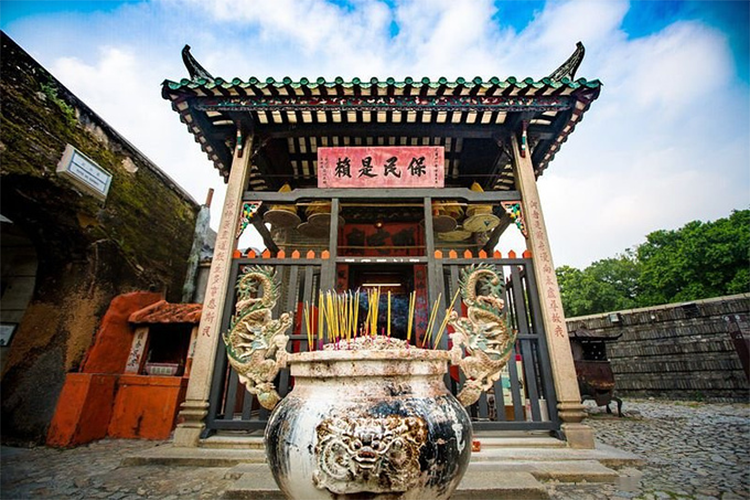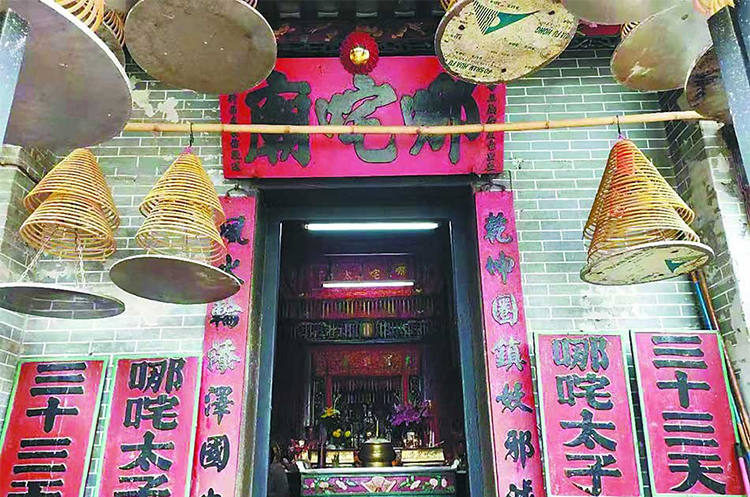Macau UNESCO Heritage: Nezha Temple — Tiny Taoist Gem in the Historic Centre
Macau Nezha Temple: Tiny Taoist Gem in UNESCO Centre
Introduction
In the heart of Macau’s Historic Centre, beside the Ruins of St. Paul’s, stands a diminutive yet remarkable shrine occupying just 20 square meters: the Nezha Temple. One of Macau’s smallest temples, it encapsulates centuries of local faith and cultural exchange. Step through its painted wooden doors and you’ll find a compact, finely detailed space where Cantonese temple craft meets Portuguese decorative touches. The childlike yet martial statue of Nezha presides over softly burning incense—an intimate, living witness to Macau’s fusion of East and West. As part of Macau’s UNESCO-listed Historic Centre, this tiny Taoist temple is a concentrated cultural treasure.
1. Core Features: A “Mini Cultural Museum” in a World Heritage Site
“A Nezha worship center where Lingnan style meets Western elements” — the temple’s charm lies in its blend of Chinese folk belief with Macau’s colonial past.
– Small but profound: Covering only about 20 square meters, it is one of two surviving Nezha temples in Macau (the other is at Shìshan). It has been called the “smallest World Heritage” site in spirit.
– Architectural fusion: Traditional pitched Chinese roofs and painted wooden doors sit alongside Western-style pediments and reliefs, a literal meeting of architectural cultures.
– Living folk tradition: The Nezha birthday parade on lunar May 18 is one of Macau’s liveliest folk events—devotees carry the statue through old streets amid drums and celebration.
2. History: From Local Shrine to World Heritage Component
– Founded in 1888 to help ward off local epidemics, the temple later became an important center for Nezha devotion.
– In 2005 the temple was included as part of the UNESCO-listed Macau Historic Centre, symbolizing the city’s long history of religious coexistence.
– Cultural role: Beyond being a Taoist site, it is a living artifact of Macau’s Sino-Portuguese cultural fusion, attracting scholars, worshippers, and curious visitors.

3. Architecture and Art: Small Scale, Complete Details
Architectural Style and Symbolism
– Lingnan features: Sloping tiled roofs, gray brick walls, and carved wooden doors and windows reflect traditional Cantonese (Guangdong) architecture.
– Western motifs: The façade’s decorative pediments and reliefs show Portuguese influence from Macau’s colonial era.
– Spatial arrangement: Despite the compact footprint, the altar, incense table, and shrine are arranged with careful symmetry—an example of “small but exquisite” Taoist temple design.
Main Deities and Artistic Highlights
– Main deity Nezha: The statue depicts the youthful Third Prince Nezha—innocent but martial—symbolizing protection and the expulsion of evil.
– Secondary guardians: Wei Tuo (Skanda) with a vajra and the Tai Sui deity overseeing yearly fortunes are also worshipped, offering a range of blessings.
– Painting and carving: Vivid door gods, finely carved woodwork, and Western-influenced decorative details create a striking visual contrast.
4. Religious Activities and Visitor Experience
Daily and Festival Practices
– Daily devotion: Locals regularly light incense, draw fortune sticks, and offer fruit—an authentic glimpse of living folk religion.
– Nezha birthday parade (lunar May 18): A major annual spectacle in Macau, the procession snakes through historic alleys with dragon and lion dances; visitors can watch or join in the blessings.
Visitor Etiquette
– Incense protocol: Usually three incense sticks are offered—first to Nezha, then to secondary deities.
– Keep quiet: The temple is small and solemn; please avoid loud behavior.
– Donations: A merit box is available; offerings are voluntary and heartfelt devotion matters more than amount.

5. Atmosphere: A Quiet Sanctuary in a Bustling Area
– Visitor profile: Primarily local worshippers and culture-minded tourists.
– Ambience: Despite being in the busy St. Paul’s area, the temple offers a moment of calm and spiritual focus.
– Setting: Nestled near the Ruins of St. Paul’s and shaded by trees, it provides a layered historical scene where past and present meet.
6. Suggested Itinerary
– Recommended stay: 30 minutes to 1 hour—suitable for a brief visit or a deeper cultural experience.
– Best time: Early morning or late afternoon to avoid tour group crowds and enjoy a peaceful visit.
– Nearby combinations:
– Culture loop: Ruins of St. Paul’s → Nezha Temple → Macau Museum → St. Paul’s College ruins.
– Faith trail: Nezha Temple → A-Ma Temple → St. Lawrence’s Church (to experience Macau’s religious diversity).

7. Practical Tips
Basic Info
– Address: Diagonal Lane beside the Ruins of St. Paul’s, Macau Historic Centre.
– Opening hours: 08:00–18:00. No admission fee.
Getting there
– Bus: Routes 3, 4, 6A, 8A and others stop at “Ruins of St. Paul’s”—a short 3-minute walk.
– Walking: From Senado Square, follow Rua da Palha up to the St. Paul’s area.
Notes
– Dress: No strict dress code, but avoid overly revealing clothing.
– Photography: Allowed, but flash photography is prohibited.
– Payments: Donation boxes accept cash (MOP/HKD) only.
8. Local Insight
– Best experience: Visit at dawn to see sunlight filter through painted screens onto the shrine—a serene, almost sacred moment.
– Cautions: Avoid unofficial fortune-telling stalls nearby; respect the deities and do not touch the statues.
Conclusion
Though tiny, Macau’s Nezha Temple is a concentrated treasury of faith, history, and art. It reveals the pulse of Macau’s cultural fusion and the vitality of folk religion. Whether you are a cultural explorer, architecture enthusiast, or simply seeking a quiet moment amid the city’s bustle, this UNESCO-linked Taoist shrine is well worth a stop. On your next Macau visit, step inside the Nezha Temple and let this small but powerful cultural memory linger in your journey.


